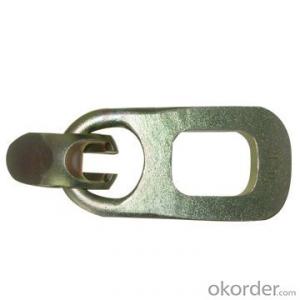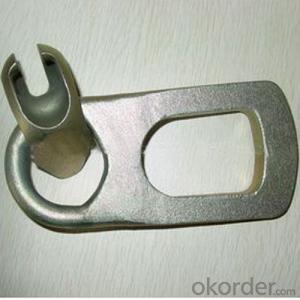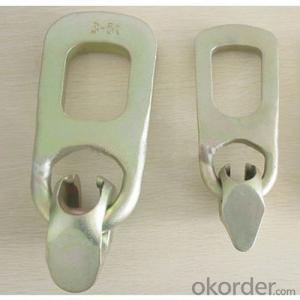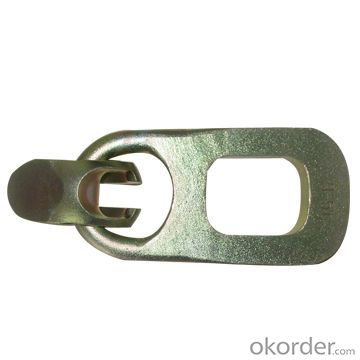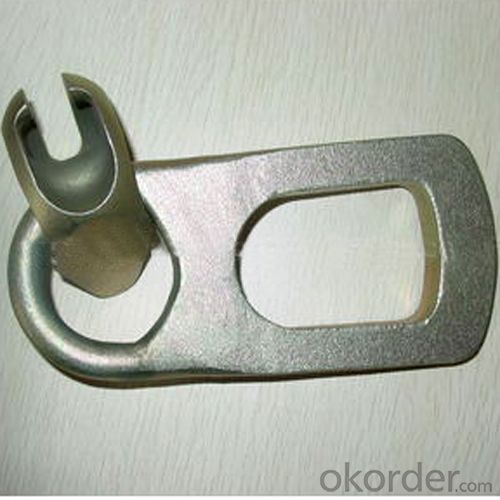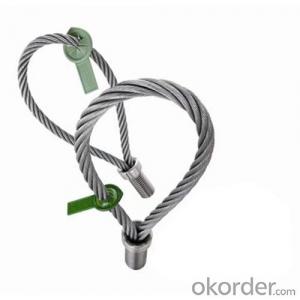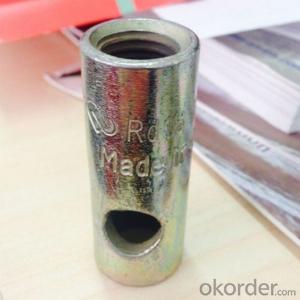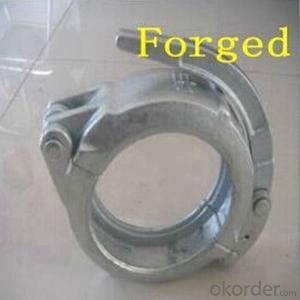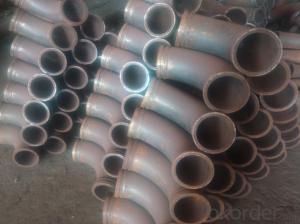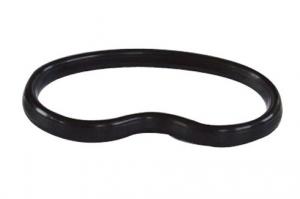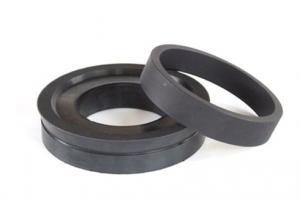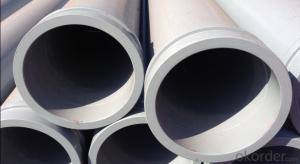Forged Concrete Ring Lifting Clutch with Hot-Dip Galvanized
- Loading Port:
- Tianjin
- Payment Terms:
- TT OR LC
- Min Order Qty:
- 100 pc
- Supply Capability:
- 10000 pc/month
OKorder Service Pledge
OKorder Financial Service
You Might Also Like
1. Materials: steel, hi tensile alloy steel, alloy steel, 20Mn2
2. Specification:
P-52 SL anchor
P-53 SL eye anchor
T - anchor
Eye anchor
3. Axial capacities load: 1.3T, 2.5T (2T), 5.0T (4T), 10.0T (8T), 20.0T, 32.0T
4. Primary competitive advantages:
1. More than 10 years focus on building material manufacturing
2. Prompt delivery time within 25 days after confirming order
3. Eathu's products are enhanced by the QA and quality control checks during the production, if necessary each order can be send out with a certificate referring back to test.
4. Precast concrete elements may be lifted several times after casting and during storage and erection-by using this system, the designer and the worker manager ensure that each lift is carried out safely and quickly.
5.Packaging and delivery:
Packaging details: goods packed in cartons and then on the pallet
Delivery detail: within 25 days after getting payment
· Experienced Staff
· Form A
· Guarantee/Warranty
· Packaging
· Price
· Product Features
· Product Performance
· Prompt Delivery
· Quality Approvals
· Reputation
· Service
· Small Orders Accepted
· More than 10 Years Experience
· Testing before shipping
Market:
Asia
Australasia
Central/South America
Mid East/Africa
North America
Western Europe
FAQ:
Q1: How long about delivery time Concrete Lifting Insert ?
A1: The delivery time will be very short, normally we keep the raw materials for old customers and sometime we also keep stock products to
make sure delivery time in any emergency cases.
Q2: How do we guarantee the quality of our Concrete lifting Insert ?
A2: We have established an advanced quality management system which conducts strict quality tests at every step, from raw materials to the final product. At the same time, we provide extensive follow-up service assurances as required.
Q3: How soon can we receive the product after purchase?
A3: Within three days of placing an order, we will book the vessel for goods. The specific shipping date is dependent upon international and government factors, but is typically 7 to 30 workdays.
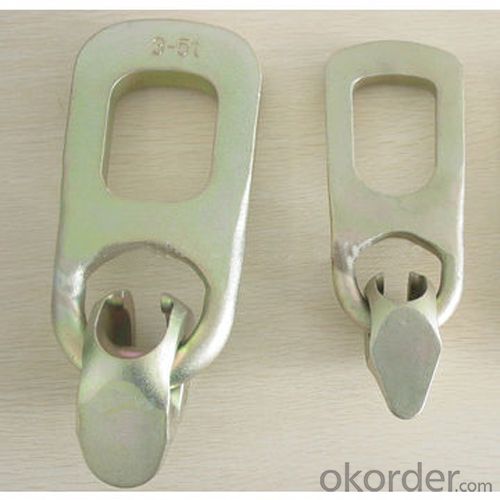
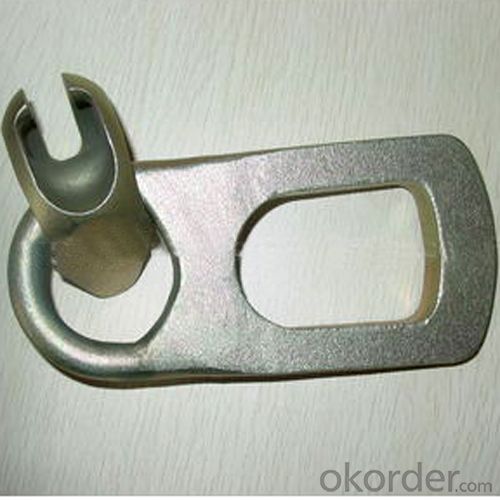
- Q: What are the different types of concrete pump hopper vibrators?
- There are two main types of concrete pump hopper vibrators: electric and pneumatic. Electric vibrators are powered by electricity and use an electric motor to generate vibrations. They are typically more powerful and efficient but require a power source. Pneumatic vibrators, on the other hand, are powered by compressed air and use air pressure to create vibrations. They are portable and do not require a power source, making them more suitable for remote or inaccessible areas.
- Q: What is the function of a concrete pump hopper grate pin?
- The purpose of a pin on a concrete pump hopper grate is to keep the grate securely in place and prevent it from moving or coming loose while concrete is being pumped. The pin acts as a locking mechanism, ensuring that the grate stays stable and does not pose any dangers or interrupt the pumping process. Furthermore, the pin allows for simple removal and replacement of the grate when needed, making it easier to maintain and clean the hopper. In conclusion, the concrete pump hopper grate pin is vital for preserving the reliability and effectiveness of the concrete pumping equipment.
- Q: How can a faulty boom affect the concrete placement process?
- A faulty boom can have significant implications on the concrete placement process. Firstly, it can compromise the safety of the workers involved. A faulty boom may not be able to support the weight and pressure exerted by the concrete, leading to potential collapse or failure, endangering the lives of the workers present at the site. Secondly, a faulty boom can result in inaccurate and uneven concrete placement. The boom's malfunctioning parts may cause the concrete to be discharged at incorrect angles or distances, leading to uneven distribution and an inconsistent concrete surface. This can affect the structural integrity and aesthetics of the final product. Additionally, a faulty boom can lead to delays and disruptions in the concrete placement process. If the boom breaks down or malfunctions during the operation, it will require repairs or replacement, causing downtime and potentially halting the construction work. This can result in project delays, increased costs, and overall inefficiency. Lastly, a faulty boom can result in wastage of concrete. If the boom is not functioning properly, it may not be able to control the flow and discharge of the concrete accurately. This can lead to spills, overflows, or excessive pouring, resulting in unnecessary wastage of concrete material. This not only increases project costs but also has environmental implications. Overall, a faulty boom can have severe consequences on the safety, accuracy, efficiency, and cost-effectiveness of the concrete placement process. It is crucial to ensure that booms are regularly inspected, properly maintained, and promptly repaired to mitigate any potential risks and ensure smooth concrete placement operations.
- Q: Are there any specific maintenance procedures for concrete pump spare parts?
- Yes, there are specific maintenance procedures for concrete pump spare parts. Regular maintenance is crucial to ensure the effective functioning and longevity of the equipment. Here are some key maintenance procedures for concrete pump spare parts: 1. Lubrication: Regularly lubricate all moving parts such as pistons, cylinders, and valves to minimize friction and wear. This helps to maintain smooth operation and prevent premature failure. 2. Cleaning: Clean the spare parts regularly to remove any debris, dirt, or concrete buildup. Accumulated material can hinder the performance and cause damage to the parts. Use appropriate cleaning agents and tools to ensure a thorough cleaning. 3. Inspection: Conduct routine inspections of all spare parts to identify any signs of wear, damage, or deterioration. Check for cracks, leaks, loose connections, or any abnormal functioning. Timely detection of issues allows for prompt repairs or replacements. 4. Replacement: Replace worn-out or damaged concrete pump spare parts as soon as necessary. Delaying replacements can lead to further damage and potentially expensive repairs. Follow the manufacturer's recommendations for the lifespan of specific parts and replace them accordingly. 5. Calibration: Ensure that all spare parts are correctly calibrated to maintain optimum performance. This includes adjusting pressure settings, flow rates, and other parameters according to the manufacturer's guidelines. Regular calibration helps to ensure accurate and efficient concrete pumping. 6. Storage: Properly store spare parts when not in use to prevent damage from environmental factors. Keep them in a clean and dry place, away from direct sunlight or extreme temperatures. Additionally, follow any specific storage instructions provided by the manufacturer. 7. Training: Train operators and maintenance personnel on the proper handling, maintenance, and repair of concrete pump spare parts. This will ensure that the procedures are followed correctly, minimizing the risk of damage and maximizing the lifespan of the equipment. By following these specific maintenance procedures, concrete pump spare parts can be kept in optimal condition, enhancing their performance, reliability, and longevity.
- Q: Can I get spare parts for both concrete pumps with and without boom control systems?
- Yes, you can typically get spare parts for both concrete pumps with and without boom control systems. Many manufacturers and suppliers of concrete pumps offer a wide range of spare parts to meet the needs of different types of pumps. Whether it's for a pump with a boom control system or one without, you should be able to find the necessary spare parts from reputable suppliers. It is recommended to contact the manufacturer or supplier directly to inquire about the availability and compatibility of spare parts for your specific concrete pump model.
- Q: How often should hopper pins be inspected or replaced in a concrete pump?
- To guarantee the safe and efficient operation of concrete pump equipment, it is imperative to regularly inspect and replace hopper pins. The frequency of these inspections and replacements depends on various factors, including the concrete pump's usage and the condition of the hopper pins. As a general rule, it is advised to inspect hopper pins every three to six months or after every 400 to 600 hours of operation. However, it is crucial to note that this timeframe can differ depending on the intensity and volume of concrete pumping activities. During the inspection, it is necessary to carefully examine the hopper pins for any indications of wear, damage, or deformation. If any pins display significant signs of wear, such as cracks, elongation, or excessive corrosion, they should be promptly replaced to prevent potential accidents or equipment failure. Maintaining the structural integrity of the concrete pump and ensuring the safety of operators and the surrounding environment rely heavily on regular inspection and replacement of hopper pins. It is advisable to consult the manufacturer's guidelines or seek professional advice to determine the specific schedule for inspection and replacement, considering the make and model of the concrete pump.
- Q: How can a faulty pressure gauge affect the concrete pumping process?
- The concrete pumping process can be significantly affected by a faulty pressure gauge in various ways. To begin with, inaccurate readings from the gauge can result in an incorrect evaluation of the pressure within the system. Consequently, this can lead to the application of excessively high or low pressure during pumping, which can cause a range of issues. If the faulty pressure gauge displays a higher pressure than the actual value, it can result in the over-pressurization of the concrete pump. This can lead to potential damage to the equipment, such as burst hoses or pipes, which poses a danger to nearby workers. Additionally, excessive pressure can cause the concrete to be pumped forcefully, potentially resulting in material splattering or leaking from the delivery system. This leads to wastage and an uneven distribution of the concrete. On the other hand, an incorrectly low pressure reading from the faulty gauge can also create problems. Insufficient pressure within the pumping system can prevent the concrete from being adequately delivered to the desired location. This can cause delays in the construction process and result in uneven or incomplete concrete placement, which affects the integrity and strength of the structure being built. Moreover, a faulty pressure gauge can contribute to the inaccurate monitoring of the concrete's slump or consistency. The pressure gauge is commonly used as an indicator of the concrete's flowability. If the gauge is faulty, it can provide misleading information about the material's workability. As a result, the concrete mix can be either too fluid or too stiff, leading to difficulties in pumping and potentially compromising the quality of the finished concrete structure. In conclusion, a faulty pressure gauge can have severe consequences on the concrete pumping process. It can cause over-pressurization, material wastage, uneven distribution, construction delays, and compromised concrete quality. Therefore, it is crucial to regularly inspect and maintain pressure gauges to ensure their accuracy and reliability. This promotes safe and efficient concrete pumping operations.
- Q: How does the concrete pump work?
- Pump in place should be flat and solid, without obstacles around, no overhead transmission line. The pump shall not be parked on the slope.
- Q: What is the second generation pumping technology of concrete pump?
- Concrete pump, S pipe distribution without PLC electrical components to participate in, the failure rate is lower, more reliable control, product life has greatly improved
- Q: Can concrete pump spare parts be recycled or disposed of responsibly?
- Yes, concrete pump spare parts can be recycled or disposed of responsibly. Many components of concrete pump spare parts, such as steel and rubber, can be recycled. These materials can be separated and processed for reuse in other industries. Additionally, responsible disposal methods, such as proper waste management systems, can be employed to ensure that any non-recyclable parts are disposed of in an environmentally friendly manner. Overall, efforts can be made to minimize the environmental impact associated with concrete pump spare parts by adopting recycling and responsible disposal practices.
Send your message to us
Forged Concrete Ring Lifting Clutch with Hot-Dip Galvanized
- Loading Port:
- Tianjin
- Payment Terms:
- TT OR LC
- Min Order Qty:
- 100 pc
- Supply Capability:
- 10000 pc/month
OKorder Service Pledge
OKorder Financial Service
Similar products
Hot products
Hot Searches
Related keywords
